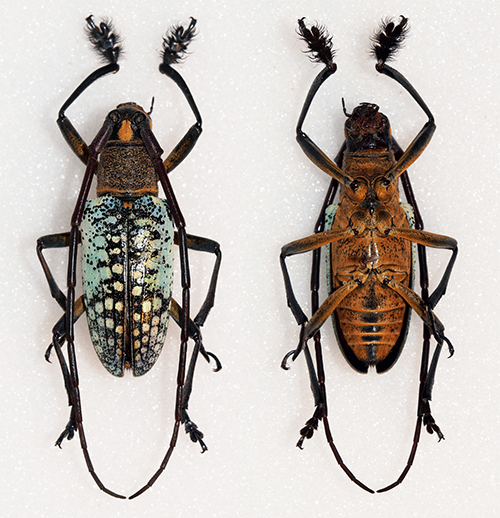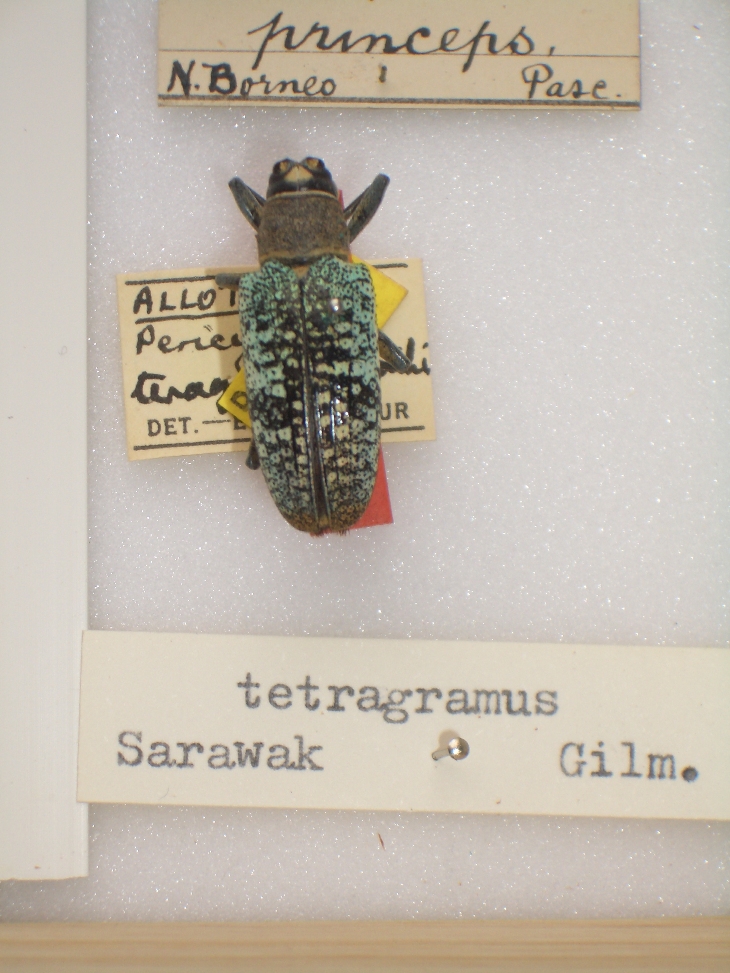| T O P I C R E V I E W |
| Bennyboymothman |
Posted - 07/01/2015 : 08:41:13

291.91 KB
Data: Male - 04-11-08 - Ranau - Sabah - Malaysia - 24mm
Hello all.
In my opinion this is Pericycos teragramus.
It was labelled as Pericycos princeps.
Thanks for any help
Ben |
| 2 L A T E S T R E P L I E S (Newest First) |
| Bennyboymothman |
Posted - 09/01/2015 : 08:30:19
Thanks for all your information, very confusing, maybe there will be a revision soon of this genus. |
| dryobius |
Posted - 07/01/2015 : 19:50:08
Gilmour (1950) writes the following:
This new species is most closely allied to P. princeps Pasc, from which it can be immediately distinguished by the elytral sutural spots not being yellow and the labrum not yellow. It may be separated from the other species as shown in the following key.
Key to the Genus Pericycos Breun.
1. The elytra covered with metallic green confluent spots 2
— The elytra covered with ochraceous spots 3
2. The labrum yellow pubescent; the elytral sutural spots yellow princeps Pascoe
— The labrum black; elytral sutural spots metallic green, like the rest teragramus sp. n.
I didn't include the rest of the key because it is not pertinent.
Unfortunately, Gilmour's lack of exposure to a good series of specimens resulted in the description of a species which is probably not valid. The first character he mentions: "elytral sutural spots not being yellow", does not work, as the specimens I have seen vary significantly and evenly from no yellow (or ochraceus), to a trace of yellow, all the way to clearly spotted with yellow (ochraceus). Here I post a photo of the ALLOTYPE in the BMNH. Who knows what Gilmour did with the holotype (I think he was put in prison for stealing specimens from the BMNH, right? Anyway, that is another story)
What remains is the discussion of whether the labrum is really different, or if it is really significant. I have looked at 3 specimens (2 male + 1 female) and to me it looks like the labrum is black with numerous, but thinly scattered yellow (ochraceus) hairs. In Gilmour's key, he has simply said that P. princeps has a black labrum, but does not mention it having any pubescence. To me, I believe that pubescence on the labrum can be easily lost by any number of events in a beetle's life or post mortem.
P. princeps does have an oval ochraceus patch of pubescence located below and in front of each eye. I have one specimen (female) of Pericycos from the same locality which has just one large ochraceus patch located below both eyes and the elytral maculae are almost entirely ochraceus. Note, that I prefer to use the term ochraceus rather than yellow, because to me the color here is not yellow.
Personally, I believe teragramus is a synonym of princeps. And I believe there is probably an undescribed Pericycos in Borneo.
There is a high probability that Breuning's subspecies "P. princeps flavoapicalis" from Borneo, is not good, either. Someday, I'm sure someone will publish something about this mess.

457.28 KB |
|
|


